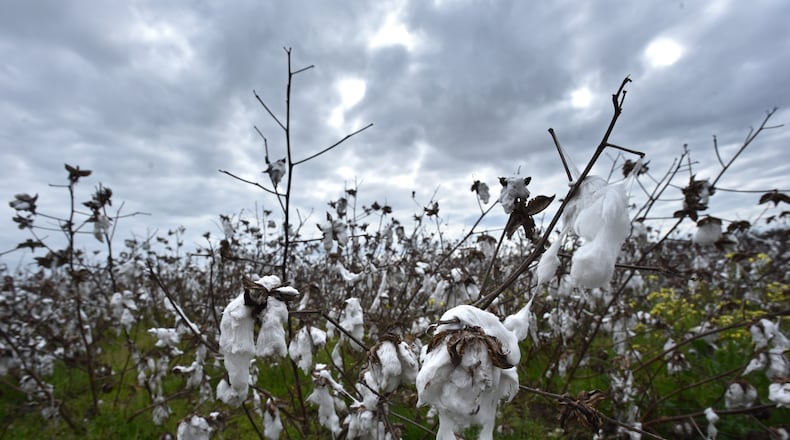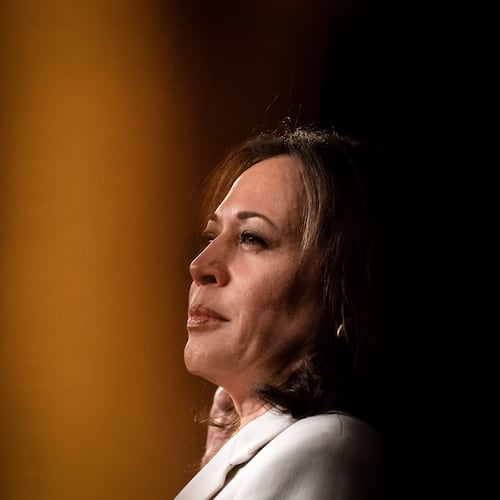Last October, Hurricane Michael leaped out of the Gulf of Mexico and plowed through cotton fields and pecan groves in southwest Georgia.
Nearly a year later, on Monday, Secretary Sonny Perdue announced that the U.S. Department of Agriculture would begin accepting applications from farmers – here and elsewhere — for more than $3 billion in aid set aside for disaster relief.
With luck, farmers might see some actual cash by January.
Those sighs of relief you hear aren’t just coming from those who work the land in the 80 Georgia counties that qualify — the ones who saw Michael pick $2.5 billion from their pockets, just as the trade war with China began to kick in.
Those sighs are coming from the White House, too, and anywhere there’s a Republican dependent on President Donald Trump’s standing in 2020.
At this point, Trump’s re-election strategy appears to be a repeat of 2016, when ramped-up turnout in rural America gave the TV reality star 304 electoral votes and the keys to the White House. It was a close-run thing.
But Trump is an incumbent this time, with a record to defend. And one of the most significant aspects of the first few weeks of the 2020 presidential primary gauntlet – from the Iowa caucuses on Feb. 3 to the Georgia vote on March 24 – is that they coincide with the most important season on the farm calendar.
Not planting season. Not harvest season. But planning season.
In much of agribusiness, with the ground too cold to seed, the first quarter is given over to financial affairs. Last year’s profits or losses are tallied. The future is defined by loan discussions with banks — because there’s acreage to be rented, if affordable, and seed to order. Along with tending equipment, these are a crop farmer’s winter chores.
“While it’s cold and dreary outside, they’re working with a pencil to get things lined up,” said Richey Seaton, executive director of the Georgia Cotton Commission.
In other words, if the 2020 presidential race is one based on economic well-being, January, February and March are when farmers will know exactly where they stand in the wake of a trade war with China that has already lasted 18 months – never mind those unending assaults from Mother Nature.
That could become at least an annoyance for President Trump, who has now picked up his fourth primary challenger in former South Carolina congressman and governor Mark Sanford.
Republicans in South Carolina have cancelled that state’s Feb. 15 primary. The Nevada GOP has deep-sixed its Feb. 25 caucus. But Iowa is still in play, and farmers will have an outsized role in the results. New Hampshire’s GOP primary, to be held eight days later, is still on as well.
State GOP officials indicated this week that they don’t intend to seek the legislation that would be necessary to call off the primary here. So Georgia’s farm community will have two opportunities, in March and in November, to endorse the president’s trade war – or not.
So let’s talk trade.
If you want to make a south Georgia farmer’s eyeballs roll clear to the back of his head, begin with soybeans and China. Tofu may be big elsewhere, but soybeans don’t loom very large in this state’s export strategies.
Poultry, cotton, peanuts and pecans do. We’ll stick with cotton. Georgia produces 3.5 million bales a year – 85 percent of which is exported. To China, Vietnam, Bangladesh and other centers of cheap clothing production.
China consumes one-third of all cotton produced in the world. Until last year, the U.S. and Brazil were China’s top sources. Then came the trade war. Cotton was among the first casualties of last summer, with China slapping on a retaliatory 25% tariff.
“The U.S. cotton market share in China is down 75%, while Brazil has quadrupled its market share. Farmers cannot continue to withstand the economic impact of the trade dispute on our bottom line,” Bart Davis Jr., owner of Davis Farms in Doerun, Ga., testified before a U.S. House subcommittee in May.
That month, the price of cotton futures dropped to 60 cents per pound. John Robinson, a professor of agricultural economics at Texas A&M University, recently told UPI that profitability kicks in at 75 cents per pound. Late Tuesday, the price of cotton futures stood at 58.12 cents per pound.
The ripple effects of that dip in price can be profound, hitting automotive and equipment retailers, discount stores, school systems and local governments.
We caught Bryan Tolar on his cell phone down in south Georgia, as he was headed toward Moultrie. For eight years, he was president of the Georgia Agribusiness Council, and is now a one-man lobbying firm specializing in agricultural matters.
“These rural communities, they survive on a strong ag economy. They need some level of certainty, and right now, that certainty is in doubt,” Tolar said. “We can draw this thing out for a while longer, in some people’s minds, but a solution needs to come.”
The problem is that tariffs create new and different trade routes. Which don’t necessarily disappear once a trade war is over.
“Even if the trade situation with China were to come to some decision, and tariffs are removed or reduced, it’s still world commodity pricing. And so the commodity pricing still may not be what it needs to be to make a rural economy work — for cotton in particular,” he said.
The Trump administration is sending nearly $30 billion to farmers, to help them out of the hole created by the trade war. It is appreciated but makes for an uncomfortable topic – especially given the current Republican warnings against runaway socialism.
This phrase comes up again and again: “That’s not where our farmers prefer to get their income. They prefer to get it from the market.”
The political impact that a winter of discontent in the farming world might have on Trump’s fortunes isn’t clear. “I don’t know what it takes for anyone to move off support for Trump. That support is strong,” Tolar said.
In a primary, in the privacy of a voting booth, protest votes become possible. Caucuses are more public affairs. But as we said at the outset, the Trump strategy in rural America is based on intensity. In a November general election, simply sitting on one’s hands could become an option for many a farmer who doesn’t want to be called out by a neighbor.
Georgia’s presidential primary is March 24. The ground will still be too cold to plant cotton. Peanuts must wait until mid-April. But if in mid-March, you see Mark Sanford sprouting out of a field in south Georgia, you’ll know something is up.
About the Author
The Latest
Featured




